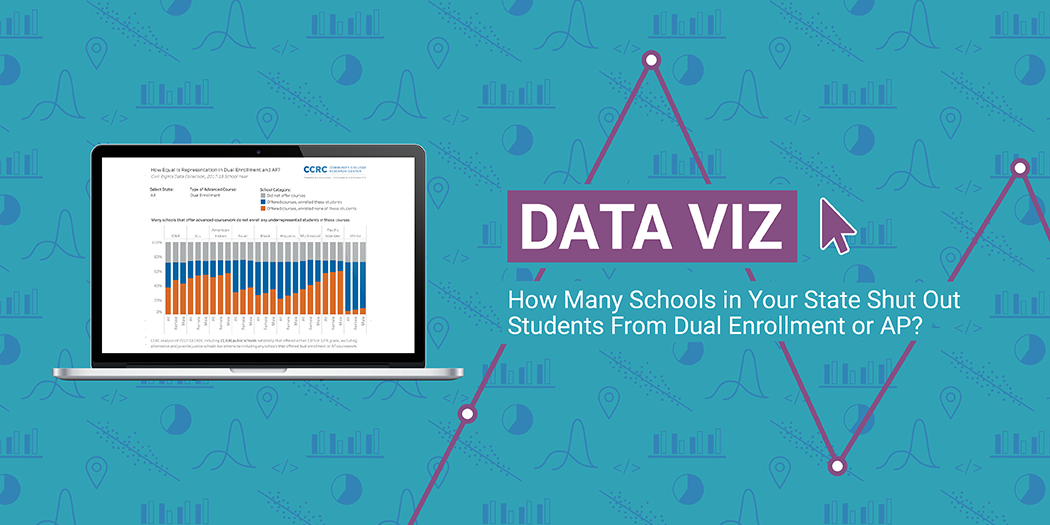Millions of high school students take advantage of dual enrollment and Advanced Placement (AP) coursework each year to earn college credit, and the programs have shown consistent benefits for students. Yet, exclusionary policies, practices, and mindsets have resulted in unequal access to these early college opportunities, and some students are shut out from advanced courses. Building on prior work on racial equity gaps in access to these courses, this analysis now includes results for students with disabilities and English language learners—providing an even more detailed illustration of which groups of students were over- and under-represented in dual enrollment and AP courses during the 2017-18 school year.
Compared to their high school enrollments nationally, Black and Hispanic students, students with disabilities (served under IDEA or the Individuals with Disabilities Education Act), and English language learners (ELL) were severely underrepresented in dual enrollment and AP courses. Male students in each of these groups were particularly underrepresented.
Comparing the representation of students among the high school population to their representation among dual enrollment or AP course takers, the chart shows that students with disabilities, for instance, comprised 13% of the school population overall, yet they only accounted for 4% of dual enrollment students and 2% of AP students. As such, students with disabilities are underrepresented in dual enrollment by 9 percentage points and in AP courses by 11 percentage points. There are similar, though slightly smaller, gaps for English language learners and Black and Hispanic students. White students, on the other hand, are overrepresented in dual enrollment and AP courses, accounting for a much larger share of students in these courses than they do among high school students overall.
Offering AP and Dual Enrollment Is Not Enough
While the high school students attend can make a big difference in whether they participate in AP or dual enrollment, students of color, students with disabilities, and English language learners have been shut out from advanced opportunities even at schools that offer dual enrollment or AP courses.
The chart below shows what percentage of schools offered any of these courses, and whether those schools enrolled any students from a given subgroup in dual enrollment or AP courses.
Some schools do not offer dual enrollment or AP at all (gray bars)—and other research has shown that these schools serve higher proportions of low-income students and students of color. But, as the chart above shows, even among schools that offer these opportunities and enroll students of color, students with disabilities, or English language learners, too often these schools do not enroll any students from these underrepresented groups in dual enrollment or AP courses (orange bars). For example, 27% of schools that enrolled Black students offered dual enrollment courses but did not enroll any Black students in those courses. In the chart above, you can select results for your state and examine what percentage of schools have shut out students with disabilities, English language learners, and students by race/ethnicity from dual enrollment and AP coursework.
Resources for Expanding Access to Dual Enrollment
Building from this analysis of national data, community college leaders seeking to expand access to dual enrollment coursework should consider the following questions:
- What are the exclusionary policies, practices, and mindsets that have resulted in unequal access to dual enrollment in our service area?
- How can we work with our primary high school partners to increase participation by closing gaps in representation within their schools?
- Which high schools in our service area do we not partner with as often? Do they serve large numbers of students who are currently underrepresented? What is the potential to develop partnerships with those schools?
In 2020, CCRC and the Aspen Institute released the Dual Enrollment Playbook, which detailed the practices of nine community colleges and their K-12 partners that had closed gaps in access to dual enrollment and in college success for students of color in dual enrollment. An entire chapter of this playbook was dedicated to showcasing effective strategies for expanding access to dual enrollment (see pages 20-29 of the Dual Enrollment Playbook). Drawing on the findings from this chapter, college leaders may also find useful the accompanying institutional self-assessment rubric (see pages 4-5 for the section on expanding access) and the “getting started guide,” which presents ideas for engaging your K-12 partners and finding common ground to make joint commitments on expanding access (e.g., who to invite, materials to prepare, questions to discuss).
Partnering with their high school colleagues, community college educators committed to expanding equity and access have shown it is possible to broaden the benefits of dual enrollment. And improvement is essential if colleges are to expand opportunity for students while also building back their enrollment.





